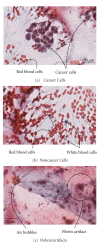Computerized decision support system for intraoperative analysis of margin status in breast conservation therapy
- PMID: 23213570
- PMCID: PMC3505663
- DOI: 10.5402/2012/546721
Computerized decision support system for intraoperative analysis of margin status in breast conservation therapy
Abstract
Background. Breast conservation therapy (BCT) is the standard treatment for breast cancer; however, 32-63% of procedures have a positive margin leading to secondary procedures. The standard of care to evaluate surgical margins is based on permanent section. Imprint cytology (IC) has been used to evaluate surgical samples but is limited by excessive cauterization thus requiring experienced cytopathologist for interpretation. An automated image screening process has been developed to detect cancerous cells from IC on cauterized margins. Methods. IC was prospectively performed on margins during lumpectomy operations for breast cancer in addition to permanent section on 127 patients. An 8-slide training subset and 8-slide testing subset were culled. H&E IC automated analysis, based on linear discriminant analysis, was compared to manual pathologist interpretation. Results. The most important descriptors, from highest to lowest performance, are nucleus color (23%), cytoplasm color (15%), shape (12%), grey intensity (9%), and local area (5%). There was 100% agreement between automated and manual interpretation of IC slides. Conclusion. Although limited by IC sampling variability, an automated system for accurate IC cancer cell identification system is demonstrated, with high correlation to manual analysis, even in the face of cauterization effects which supplement permanent section analysis.
Figures




Similar articles
-
Intraoperative imprint cytology for real-time assessment of surgical margins during partial nephrectomy: A comparison with frozen section.Urol Oncol. 2015 Feb;33(2):67.e25-9. doi: 10.1016/j.urolonc.2014.07.016. Epub 2014 Aug 28. Urol Oncol. 2015. PMID: 25176582
-
Use of imprint cytology for assessment of surgical margins in lumpectomy specimens of breast cancer patients.Diagn Cytopathol. 2007 Oct;35(10):656-9. doi: 10.1002/dc.20704. Diagn Cytopathol. 2007. PMID: 17854083
-
Quantitative automated image analysis system with automated debris filtering for the detection of breast carcinoma cells.Acta Cytol. 2011;55(3):271-80. doi: 10.1159/000324029. Epub 2011 Apr 27. Acta Cytol. 2011. PMID: 21525740 Free PMC article.
-
Local recurrence in lumpectomy patients after imprint cytology margin evaluation.Am J Surg. 2004 Oct;188(4):349-54. doi: 10.1016/j.amjsurg.2004.06.024. Am J Surg. 2004. PMID: 15474425 Review.
-
Intraoperative imprint cytology of sentinel nodes in breast cancer.J Surg Oncol. 2004 Jun 1;86(3):128-33. doi: 10.1002/jso.20067. J Surg Oncol. 2004. PMID: 15170650 Review.
Cited by
-
Diagnostic Accuracy Comparison of Artificial Immune Algorithms for Primary Headaches.Comput Math Methods Med. 2015;2015:465192. doi: 10.1155/2015/465192. Epub 2015 May 4. Comput Math Methods Med. 2015. PMID: 26075014 Free PMC article.
-
Use of monoclonal antibody-IRDye800CW bioconjugates in the resection of breast cancer.J Surg Res. 2014 May 1;188(1):119-28. doi: 10.1016/j.jss.2013.11.1089. Epub 2013 Nov 22. J Surg Res. 2014. PMID: 24360117 Free PMC article.
-
The status of contemporary image-guided modalities in oncologic surgery.Ann Surg. 2015 Jan;261(1):46-55. doi: 10.1097/SLA.0000000000000622. Ann Surg. 2015. PMID: 25599326 Free PMC article. Review.
References
-
- Méndez JE, Lamorte WW, de las Morenas A, et al. Influence of breast cancer margin assessment method on the rates of positive margins and residual carcinoma. American Journal of Surgery. 2006;192(4):538–540. - PubMed
-
- Dunne C, Burke JP, Morrow M, Kell MR. Effect of margin status on local recurrence after breast conservation and radiation therapy for ductal carcinoma in situ. Journal of Clinical Oncology. 2009;27(10):1615–1620. - PubMed
-
- Klimberg VS, Harms S, Korourian S. Assessing margin status. Surgical Oncology. 1999;8(2):77–84. - PubMed
-
- Obedian E, Haffty BG. Negative margin status improves local control in conservatively managed breast cancer patients. Cancer Journal from Scientific American. 2000;6(1):28–33. - PubMed
-
- Cox CE, Hyacinthe M, Gonzalez RJ, et al. Cytologic evaluation of lumpectomy margins in patients with ductal carcinoma in situ: clinical outcome. Annals of Surgical Oncology. 1997;4(8):644–649. - PubMed
